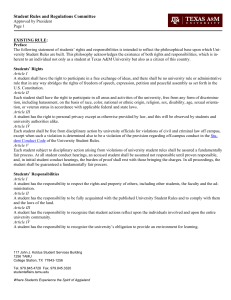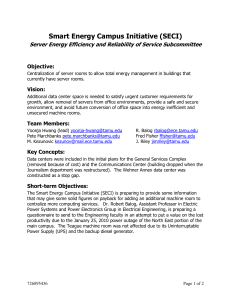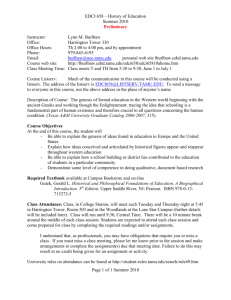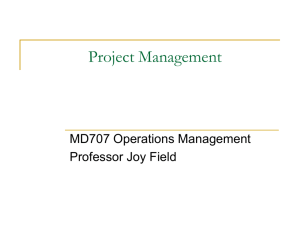Report on Predictive Science Courses
advertisement
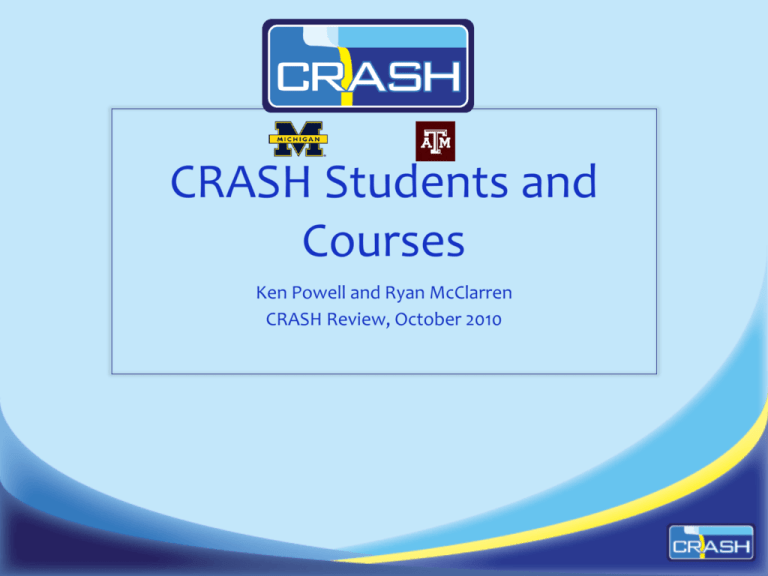
CRASH Students and Courses Ken Powell and Ryan McClarren CRASH Review, October 2010 About Our Students Each UM and TAMU student has a home department Current students from Atmospheric, Oceanic and Space Sciences (UM) Aerospace Engineering (UM) Applied Physics (UM) Computer Science (UM, TAMU) Mathematics (UM) Statistics (UM, TAMU) Nuclear Engineering (UM, TAMU) Many CRASH students co-advised About Our Students Students funded from several sources CRASH center funds CRASH fellowship cost-sharing funds Non-CRASH fellowship or RA funds Students engaged in CRASH community Student involvement in 22 of the posters Strong connections to NNSA labs Several students visited labs in 2010 Maginot (LANL), Pandya (LLNL), Stripling (LLNL), Zaide (LANL), Huntington (LLNL), Starinshak (LLNL) Several possibilities for visits to the labs in 2011/12 Ongoing effort to encourage this and make connections Selected Student Research Topics Modeling and Theory Discontinous Galerkin methods for hydrodynamics Coupling methods for rad-hydro Radtran and turbulence effects in blast waves Time discretization methods for radtran Experiments Structure in radiative shocks Radiative shock experiments at the OMEGA facility Reverse radiative shocks Hydrodynamic shock experiments at the OMEGA facility UQ Unsteady adjoints for error estimation and AMR Bayesian and traditional regression methods for analysis of data from highdimensional computational experiments CRASH Courses Predictive Science course at TAMU First offered Fall 2009 Taught by Ryan McClarren Covered verification, validation, sensitivity analysis and UQ 9 students Uncertainty Quantification course at UM First offered Winter 2010 Team-taught by James Holloway, Vijay Nair, Ken Powell Focused on input/output modeling, screening and sensitivity analysis, UQ 24 students TAMU Predictive Science Course Verification Numerical analysis preliminaries Verification with exact solutions Manufactured Solutions Designing a test suite Analyzing the results Validation Validation using experimental data Model drill-down Uncertainty quantification and sensitivity analysis Statistics preliminaries Sensitivity analysis Stochastic uncertainty quantification Reliability methods Polynomial chaos Bayesian inference / Calibration Dealing with epistemic uncertainty Structure of TAMU Course The course had students from nuclear engineering, geophysics, and statistics. Course was lectured-based with graded homework. Final project covered a topic of the student’s choice. In final project the students had to include V&V of the code/model they were using Uncertain inputs A prediction with quantified uncertainty Sample Final Projects – TAMU course Several used polynomial chaos techniques to Compute the uncertainty in dose for a radiation shielding calculation. Predict maximum temperature / flux in coupled neutronics heat conduction simulation. Compute sensitivity to coupling schemes in multiphysics problems. Predict the spectral radius of a transport solve using a Kennedy-O’Hagan model UM Uncertainty Quantification Course Introduction Sources and types of Sampling the input space (Monte Carlo, Latin Hypercube, design of experiments) uncertainty Key probability concepts used in UQ Uncertainty quantification Overview of UQ process Estimating output uncertainties Input/Output Modeling Reducing input uncertainties Emulators and response for a new prediction surfaces Estimating model discrepancy Parametric regression function Semi-parametric modeling Building a predictive model (MARS, MART) Gaussian process modeling Structure of UM course Lectures Lab sessions Introduced background probability and statistics information Introduced software (MATLAB, R) Worked examples related to lectures Homeworks introduced key concepts, based on a simple simulation code written by each student (trajectory of a ball) Final projects, based on their own research, presented in final weeks of class Sample Final Projects – UM course MARS/MART analysis of drag in a Mars Re-entry system Gaussian process modeling and Markov-Chain Monte Carlo for turbulence model calibration UQ analysis of a Fischer-Tropsch synthesis process Constructing and sampling a response surface for radiative heat transfer in a scramjet UQ in military ground vehicle blastworthiness simulations Blastworthiness Project Concluding Remarks Both classes drew a diverse student group – there is real interest in the topic among grad students The combination of simpler homework sets to teach the concepts and final projects driven by the students’ research worked well

